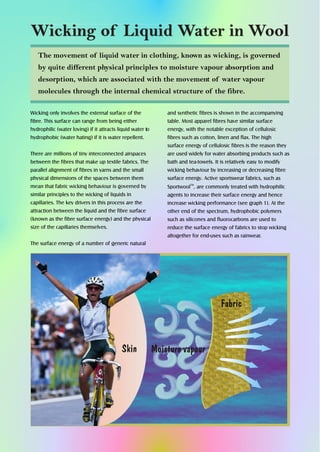
Wicking of wool
- 1. Wicking of Liquid Water in Wool The movement of liquid water in clothing, known as wicking, is governed by quite different physical principles to moisture vapour absorption and desorption, which are associated with the movement of water vapour molecules through the internal chemical structure of the fibre. Wicking only involves the external surface of the and synthetic fibres is shown in the accompanying fibre. This surface can range from being either table. Most apparel fibres have similar surface hydrophilic (water loving) if it attracts liquid water to energy, with the notable exception of cellulosic hydrophobic (water hating) if it is water repellent. fibres such as cotton, linen and flax. The high surface energy of cellulosic fibres is the reason they There are millions of tiny interconnected airspaces are used widely for water absorbing products such as between the fibres that make up textile fabrics. The bath and tea-towels. It is relatively easy to modify parallel alignment of fibres in yarns and the small wicking behaviour by increasing or decreasing fibre physical dimensions of the spaces between them surface energy. Active sportswear fabrics, such as mean that fabric wicking behaviour is governed by SportwoolTM, are commonly treated with hydrophilic similar principles to the wicking of liquids in agents to increase their surface energy and hence capillaries. The key drivers in this process are the increase wicking performance (see graph 1). At the attraction between the liquid and the fibre surface other end of the spectrum, hydrophobic polymers (known as the fibre surface energy) and the physical such as silicones and fluorocarbons are used to size of the capillaries themselves. reduce the surface energy of fabrics to stop wicking altogether for end-uses such as rainwear. The surface energy of a number of generic natural Fabric Skin Moisture vapour
- 2. Fibre Surface energy (mJm2) rate of moisture build-up Aramid -30 100% synthetic Carbon 40 -50 Cellulose 200 Polyacrylonitrile 44 sweating starts Polyamide 46 Polyester 43 Polyethylene ~22 sportwool Polypropylene 29 0 2 4 6 8 Polyvinylchloride 37 minutes of exercise Wool 29 Table 1: The surface energy of natural and synthetic Graph 1: Increased wicking performance of fibres SportwoolTM . In its natural state, the outer surface of the wool manufacture with a hydrophilic agent that slightly fibre is covered with a layer of lipids or waxy increases the surface energy of the wool but materials that are relatively hydrophobic. Wool substantially increases the surface energy of the fabrics manufactured from fibres that have not been outer polyester face. This difference in surface chemically treated do not tend to wick water or only energy is what drives the one-way wicking behaviour do so quite poorly. Some traditional wool products of Sportwool as shown in Figure 1. used before modern surface treatments were available involved coating the fabric with a natural Wicking is also a key factor in the drying of fabrics. It grease to keep water out. This was a trick used on is a popular misconception that synthetic fabrics dry their wool gloves by Scandinavian fishermen. If the more quickly than their natural counterparts. In fact lipids are removed by processes such as chlorination the rate of evaporation from fabrics depends solely or oxidised by plasma treatment the fibre surface on the prevailing climate conditions and is quite becomes quite hydrophilic. Wool fabrics treated in independent of the fibres involved. Drying time is this way wick water quite well. Machine-wash treated determined by the amount of water in the fabric that wool fabrics often wick noticeably better than their must be evaporated. After a wash and spin-dry cycle untreated equivalents. The wool used on the inner fabrics that wick strongly retain more water and take face of Sportwool for example is machine-wash longer to dry than poorly wicking fabrics. treated. Sportwool fabrics are treated after Figure 1: The wicking behaviour of SportwoolTM. 1. During vigorous 2. Sweat is picked up 3. The moisture is then 4. There it spreads out activity, the body from the skin by the rapidly pulled through to increase the area of produces sweat. inner wool layer of the to the outer layer. evaporation. Sportwool TM fabric.
